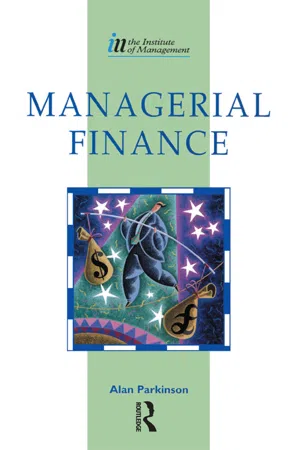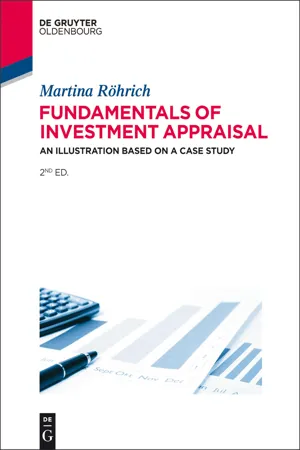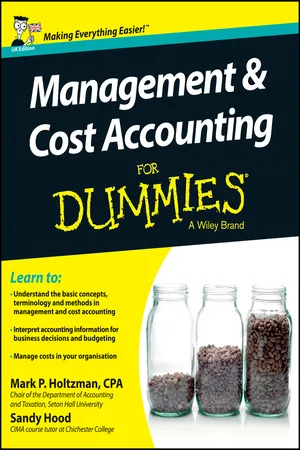Business
Net Present Value Method
Net Present Value (NPV) method is a financial technique used to evaluate the profitability of an investment by comparing the present value of expected cash inflows with the present value of cash outflows. A positive NPV indicates that the investment is expected to generate more value than it costs, making it an attractive opportunity for businesses.
Written by Perlego with AI-assistance
Related key terms
Related key terms
1 of 4
Related key terms
1 of 3
12 Key excerpts on "Net Present Value Method"
- Daniel Adrian Doss, William H. Sumrall III, Don W. Jones(Authors)
- 2017(Publication Date)
- Routledge(Publisher)
Some initiatives may require periods that are longer than those that are considered within this text. When these situations occur, it is recommended that NPV calculations be performed through the use of software spreadsheets, proprietary software, or financial calculators. Also, within the context of collegiate finance courses, a tabular solution is also available to solve NPV problems involving a variety of periods. However, for the purposes of this text, the use of the basic formula is appropriate to demonstrate the basic concept of net present value and to delineate the calculations through which NPV problems are solved. Future editions of this text, if any, are anticipated to contain the tabular solution methods of NPV problems.6.8 Chapter Comments and Summary
This chapter introduced the net present value (NPV) method of capital budgeting. The methods of capital budgeting encompass perspectives of time, cash value, rate, and profitability potential. The NPV is indicative of a cash perspective regarding the rendering of capital budgeting decisions. Further, the NPV method incorporates the time value of money within its primary construct. Derivation of the NPV method can occur through algebraic manipulation of the current monetary value formula given in Chapter 4 .The NPV method involves a consideration of the anticipated cash flows of a capital investment through time. These anticipated future values are discounted to determine their current monetary equivalencies. Conceptually, the NPV is the sum of the present monetary value of the anticipated future cash flows of a potential capital investment excluding the costs of investment. Therefore, the NPV method provides a cash-based perspective regarding capital budgeting initiatives. The NPV may be used as a solitary method of capital budgeting or may be used in conjunction with any (or all) of the capital budgeting methods described within this text. The NPV method may be used to examine single capital initiatives or multiple capital initiatives. Further, this method may be used with or without the constraints imposed by mutual exclusion conditions.- eBook - ePub
- Brümmer LM, Hall JH, Du Toit E(Authors)
- 2017(Publication Date)
- Van Schaik Publishers(Publisher)
16310The capital investment decision
Learning outcomes
After studying this chapter, you should- understand the Net Present Value Method
- know how to calculate the net present value, for both a single sum and an annuity
- know how to apply the Net Present Value Method when purchasing shares
- know how to calculate the internal rate of return
- be able to apply the internal rate of return
- be able to apply the payback period method
- be able to make prudent decisions in the investment of capital.
Capital budgeting techniques
There is an extension or modification of the time value of money concept called the net present value, abbreviated to NPV. This is a sophisticated technique, providing a method whereby investment projects that yield cash inflows into the future may be valued in the present, which deals in net monetary amounts. This technique, together with two others, namely the internal rate of return and the payback period method, will be the focus of this chapter.Examples on the Statement of Financial Position that would involve application of the NPV method would be the organisation’s purchase of fixed assets and an investor’s purchase of shares in an organisation. We shall discuss these examples when we come to the detailed discussion on capital budgeting techniques later in this chapter.In the context of this book, an investment project will refer principally to the investment of funds in the purchase of fixed assets and shares. Since nobody can afford to invest money at a loss, the Net Present Value Method is a means of determining whether or not an investment will be a profitable proposition.A second technique, the internal rate of return (IRR), is also considered a sophisticated one and is indirectly related to the NPV. As the name implies, it is 164 intended to provide a rate of return - eBook - ePub
- P. Cassimatis(Author)
- 2013(Publication Date)
- Routledge(Publisher)
For example, a machine can be purchased today for $100,000. It has a useful life of 5 years and its cash flow is forecasted to be $30,000 per year. If the required rate of return is 10%, we haveThe required rate of return is the rate the firm can obtain from comparable investment alternatives. It is also known as the discount rate, the cost of capital, the hurdle rate, or the minimum acceptable rate of return.The advantages of the Net Present Value Method are that it takes into account the time value of money, and regardless of the pattern of cash flows, a single net present value is easily calculated. Consider, for example, the two investments shown below:Project A involves an initial investment of $2,500 and expected cash flows for 3 years. Project B requires the same initial investment, an additional cash outlay of $1,000 in the first year, and positive cash flows in the second and third year. Suppose the required rate of return is 10%. Then the NPVs of the projects are:Since the NPV of A is the larger of the two, project A is the better investment.When the cost of a project is spread over a number of years, the net present value of the investment is obtained as follows:Suppose, for example, a new assembly line is installed in a manufacturing plant and it takes one year to complete construction and another year to install the equipment. Cash flows, in thousand dollars, begin in the second year as shown in Figure 4.1 .The net present value of this project is computed as follows: Figure 4.1 Cash flows of project.4.2 Internal rate of return
Perhaps the method most widely used by engineers and business managers in evaluating capital projects is the internal rate of return method, commonly known as IRR. While this method has been criticized as having serious deficiencies, its major advantage is that it expresses the profitability of a capital investment in percentage terms, a measure that is easily understood by experts and laymen alike. The internal rate of return for an investment is the rate of return (i.e. interest rate) that makes the present value of the cash flows equal to the cost of the investment. Mathematically, it is calculated from - eBook - ePub
- (Author)
- 2002(Publication Date)
- Harvard Business Review Press(Publisher)
EVA is both a tool for evaluating new projects and a metric for gauging and rewarding managerial performance. In using it as an evaluation tool, we ask, “Will this project increase economic value?” By forecasting the impact of a new project or investment on net operating income after taxes (per our formula), and subtracting the cost of capital, we can determine its economic value added—or value lost. NPV does the same thing and, thanks to the discount rate, also recognizes the cost of capital. EVA is more effective, however, as a metric for measuring and rewarding management. It encourages managers to look at how capital is employed in their units and to ask, “Is this or that particular application of capital really returning at least its full costs?” They begin to take a hard look at assets that everyone customarily thought of as free goods: freight trains, machinery, buildings, assembly lines, and so forth. And they often discover that the company would be better off liquidating those assets and redeploying the proceeds into activities with higher returns.Summing Up
This chapter has presented what many consider to be the most valuable financial tools available to business managers and analysts: net present value, internal rate of return, economic value added, and their various related concepts. These tools are far superior to payback and return on investment, which fail to recognize either the timing of cash flows or the firm’s cost of capital (or hurdle rate). In brief, their characteristics are as follows:- Net present value (NPV) is the monetary value today of a future stream of positive and negative future cash flows discounted at some annual compound interest rate. You can use NPV analysis for any number of decision-making purposes.
- Internal rate of return (IRR) is another tool that you can use to decide whether to commit to a particular investment opportunity, or to rank the desirability of various opportunities. IRR is the discount rate at which the NPV of an investment equals zero.
- Economic value added (EVA) is net operating income after tax less the cost of the capital used to obtain it. Many companies use EVA as a discipline to evaluate operations, investments, and business performance. Like NPV, it forces managers to take account of the cost of capital used in their decisions.
- eBook - ePub
Making the Compelling Business Case
Decision-Making Techniques for Successful Business Growth
- W. Messner(Author)
- 2013(Publication Date)
- Palgrave Macmillan(Publisher)
It is now time to revisit the result of the calculation: the NPV is negative and thus the calculation uncovers a non-profitable investment proposition. But what would happen if the rate of return drops from 5 per cent to 3.5 per cent? Changing the value in cell E18 to 3.5 per cent throws out a positive NPV in cell E16 and the investment proposition begins to make sense again. Alternatively, if the owner of the real estate manages to rent it out at higher rates, this could for example increase the cash inflow in the first two years to $20,000 and to $25,000 in the third and fourth year. Now the calculation shows a positive NPV of $1,115.Spreadsheets like the one in Figure 2.6 help to experiment with the input data and thus facilitate a deeper understanding of an investment’s otherwise hidden dynamics. This kind of experimenting is commonly referred to as sensitivity analysis and Section 6.6 examines its possibilities in greater detail.Summary
The firm’s wealth maximization goal (see Section 1.1 ) states that financial management should endeavor to maximize the NPV of the expected future cash flows by taking two basic parameters into account2 :The longer it takes to receive a cash flow, the lower the value decision makers place on the cash flow today.The greater the risk associated with receiving a future cash flow, the lower the value decision makers place on that cash flow today.The wealth maximization goal thus reflects the magnitude, timing, and risk associated with cash flows expected to be received in the future as a result of investment decisions. It tells financial management what investments are to be preferred and how to make decisions.However, people often fail to understand the simple mathematical rationale of the time value of money, which is really the only principle behind calculating NPV. Instead, they perceive some other methods as methodically easier to understand, apply them instead, and in this process often mess up the correctness of the calculation. NPV is always (!) the most appropriate approach to calculating business cases; Sections 2.3 –2.6 describe the most common alternative methods, highlight their weaknesses (and strengths, if at all), and explain why they are always (!) inferior to the NPV method when making decisions on investment propositions. Sometimes they are indeed appropriate to use, but the same decision can always (!) be reached with the much more straightforward NPV method. Chapter 5 - eBook - ePub
- Rob Dransfield(Author)
- 2013(Publication Date)
- Routledge(Publisher)
Compound interest – this arises when interest is added to the principal (initial sum borrowed or lent) so that from that moment on, the interest that has been added also earns interest. Adding interest to the principal is termed ‘compounding’.Calculating net present value Key TermNet present value (NPV) – the total of all cash flows restated in today’s money terms.Net present value is based on actual cash flows. These will include inflows:- Sales revenues, phased according to when they are actually received.
- Sales proceeds from the disposal of fixed assets at the conclusion of a project.
- The release of amounts invested in stocks at the end of a project.
- Government grants.
And outflows:- Investment in fixed assets.
- Creation of a working stock balance.
- Operating costs, including material, labour and expenses.
The easiest way of finding a discount factor is to look it up in an NPV table (see Table 17.3 ). This can save a lot of time and effort (discount tables can be accessed on the Internet – simply carry out a search for ‘discount tables’). For example, Table 17.3 shows that cash in four years’ time discounted at 10 per cent should be multiplied by a factor of 0.6830.Calculating the discount factorTable 17.3 A simple discount table for different rates of interest and time periodsWhen calculating NPV it is also possible to calculate the discount factor without having to rely on NPV tables (however, in the days of rapid calculation and access to computerized tables there would be little point in doing so). The calculation is shown below:Where: r = Discount rate n = Number of years For example, cash received in four years’ time to be discounted at 10 per cent is calculated as follows:We can now illustrate how discount factors are used to calculate NPV in Table 17.4 - eBook - ePub
- Keith Ward(Author)
- 2013(Publication Date)
- Routledge(Publisher)
However, money has a time value and if we are to make sensible decisions we need to incorporate the real value of future cash flows into our evaluation criteria. We can achieve this by applying discount rates to all future cash flows so that we bring them back to their equivalent present value, which makes all the project cash flows directly comparable. The most common way of doing this is to select a discount rate for the company and to apply this to all the cash flows of the project. A positive net present value indicates that the financial return from the investment is acceptable, but the opportunity costs evaluation against other potential investments must still be done. This requires comparison of what benefits could be achieved by investing in a different mix of projects and where there are constraints on the total amount of capital which can be invested, this comparison is very important. In such a situation of capital rationing, the profitability index can be used to compare relative investment returns between projects; this is done by dividing the present value of the net inflows by the value of the initial investment.Table 7.25 Comparison of internal rate of return (IRR) and accounting return on investmentSeveral major investment evaluation techniques are used by companies: 1 payback period; 2 discounted payback period; 3 Discounted cash flow (a) net present value (NPV) (b) internal rate of return (IRR); 4 Accounting return on investment (ARR).These provide different views of any project and no single criterion can be regarded as giving the answer, so many companies use a combination of techniques and adjust the results to allow for the relative risk of the investment being examined.AppendixNew car example using financial statements comparison ResuméOur sales and marketing director’s car cost £21 000 and is assumed to have a £6000 residual value at the end of three years. A fuel efficiency device becomes available for £4500 with projected savings of £2000 per year. - eBook - ePub
- Alan Parkinson(Author)
- 2012(Publication Date)
- Routledge(Publisher)
Table 7.2 can help to solve a dilemma. If a management team used an undiscounted cash flow assessment, both investments return the same net inflow of £170,000. The same applies to an undiscounted payback assessment with both investments paying back in 2.75 years. When the time value for money is considered however, a discounted NPV cash flow assessment, Investment B is favoured, returning £60,490 as opposed to £58,490 for A. On a discounted payback assessment however, Investment A pays back in 3.6 years, whereas B takes 4.4 years. Clearly, the dilemma facing the management team here is great. It is compounded by the fact that, on an IRR basis, A has a rate of 12.2% and B 11.4%.In ranking situations like this, where funds may be inadequate to finance all potentially profitable projects, or where a choice needs to be made between a number of contenders, a further method of evaluation called the profitability index could be used. This is based on the same data as the NPV method, in that a target rate of return has to be established and the NPV calculated. What then happens is that the present value of an investment’s inflows is related to the present value of its outflows in the form of a ratio, this being:Under this criterion, the two investments would be ranked as follows: The profitability index shows us the net present value of each £ invested. Under this criterion, investment B shows up better than A.It is quite common for the profitability index to be misused. This is because the term cash outflow is often interpreted as relating solely to the initial outlay at time 0. It is not unusual for net outflows to be encountered in subsequent years and these must be incorporated as outflows within the index calculation.In summary, what we can say is that the common aim of discounted cash flow techniques is to translate a projected stream of cash flows into one single index number that is then capable of comparison with other index numbers.If the projected net cash flows are discounted back to present values at a predetermined target rate of return, then the sum of these plus or minus discounted values will be the net present value of the project in absolute terms. If, on the other hand, they are discounted at a rate which results in the sum of the present values of the projected inflows equating exactly with the sum of the present values of the projected outflows, then the net present value will be nil and the rate that needs to be applied in order to achieve this balance is the internal rate of return of the project. This is consequently a relative - eBook - ePub
Corporate Finance
Theory and Practice
- Pierre Vernimmen, Pascal Quiry, Yann Le Fur(Authors)
- 2022(Publication Date)
- Wiley(Publisher)
Chapter 16 THE TIME VALUE OF MONEY AND NET PRESENT VALUEA bird in the hand is worth two in the bushFor economic progress to be possible, in normal economic conditions, there must be a time value of money, even in a risk-free environment. This fundamental concept gives rise to the techniques of capitalisation, discounting and net present value, described below.These are more than just tools, but actual reflexes that must be studied and acquired.Section 16.1 CAPITALISATION
Consider an example of a businessman who invests €100,000 in his business at the end of 2011 and then sells it 10 years later for €1,800,000. In the meantime, he receives no income from his business, nor does he invest any additional funds into it. Here is a simple problem: given an initial outlay of €100,000 that becomes €1,800,000 in 10 years, and without any outside funds being invested in the business, what is the return on the businessman's investment?His profit after 10 years was €1,700,000 (€1,800,000 – €100,000) on an initial outlay of €100,000. Hence, his return was (1,700,000 / 100,000) or 1,700% over a period of 10 years. Is this a good result or not?Actually, the return is not quite as impressive as it first looks. To find the annual return, our first thought might be to divide the total return (1,700%) by the number of years (10) and say that the average return is 170% per year.While this may look like a reasonable approach, it is in fact far from accurate. The value 170% has nothing to do with an annual return, which compares the funds invested and the funds recovered after one year. In the case above, there is no income for 10 years. Usually, calculating interest assumes a flow of revenue each year, which can then be reinvested, and which in turn begins producing additional interest.To calculate returns over a period greater than one year, we cannot simply compare the end return to the initial outlay and divide by the number of years. This is incorrect reasoning. - eBook - ePub
- Martina Röhrich(Author)
- 2014(Publication Date)
- De Gruyter Oldenbourg(Publisher)
0 . The net present value approach should be preferred to the internal rate of return because of its reinvestment assumption. Despite the superiority of the net present value approach other criteria are not completely irrelevant and useless. They may be used as supplementary measures to facilitate decision-making.- – The following were the main points covered:
- – A pre-condition for a useful application of discounting investment appraisal techniques is the possibility to identify all relevant cash flows.
- – Problems arise if interdependencies with the company’s environment exist, e. g. if it is not possible to isolate the outcomes of the investment.
- – So far, we have not considered qualitative investment assessment criteria.
- – Up to this point all techniques presented are based on certain estimates about the input data.
- – In the following chapters we introduce uncertainty as well as qualitative investment assessment criteria. Furthermore we integrate the effects of taxation, inflation and financing the investment if the borrowing and the lending interest rates are not equal. The simplifying assumptions under which the discounting methods of investment appraisal were introduced are put aside step by step.
3.8 Exercises with Answers
3.8.1 Exercises
Exercise 3-1 Basics of the discounting methods of investment appraisal- a) At the beginning of year 1 you can invest € 5,000. If the interest rate is 8 % per annum, how much will you get at the end of year 6?
- b) Suppose in three years you would need the sum of € 250,000 to buy land. Money could be left on deposit at an interest rate of 7 %. How much do you have to invest today?
- eBook - ePub
- Mark P. Holtzman, Sandy Hood(Authors)
- 2013(Publication Date)
- For Dummies(Publisher)
Table 11-6 .You follow the same process as for the house extension in ‘Homing in on NPV and decision-making’, earlier in this chapter. As the NPV for Paul is positive we recommend that he should go ahead. The split-second when he decides to go ahead will then add £76,546 to the value of his business.Working that NPVAfter you’ve calculated the NPV – by finding the annual cash flows and listing net cash flow on a year by year basis, discounting these cash flows to produce a present value for each annual cash flow and adding up all the cash flows to find the net cash flow – you may be wondering about how to use it.Well, you don’t need a company policy. Although the payback method tells you the time needed to pay back your investment, you can go ahead only if that payback period was shorter than the company policy period. But the NPV provides an absolute decision. If the NPV is a positive value it increases the value of the business; if it’s negative it reduces the value of the business. So say yes to positive NPVs, they’re worth the investment!Putting Payback and NPV into PracticeWe have a good look at the payback and NPV methods in the earlier sections ‘Getting Your Money Back: The Payback Technique ’ and ‘Understanding Time Value of Money and Net Present Value (NPV) ’, respectively, and if you’re itching to practise them yourself (and even if you’re not!), here’s your chance.For AAT exams payback is examined at level 3 and NPV at levels 3 and 4. Typically, AAT questions give candidates most of the information without requiring a lot of calculations for the net cash flows. They always provide the discount rates.Task the first: Payback See how you get on with the following task.The company Macho Machines (‘making mechanisms for real men’) has the opportunity to manufacture a new product that involves an initial capital investment of £380,000. The product has an expected life of three years, and at the end of this period the equipment bought as part of the initial investment will be sold (a disposal) for £60,000. Table 11-7 - Peter Harris(Author)
- 2010(Publication Date)
- Routledge(Publisher)
The method also takes account of the continuing value of the business or the value which can be applied to the business at the end of this investor’s time frame, which the pay-back method fails to do. The terminal value becomes a part of the projected earnings. However, this terminal value is an equally subjective judgement – based upon either a simple multiple of final year projected earnings or similar unsophisticated ‘guess’, which in reality does little but compound the inherent subjectivity of the projected earnings. In this methodology, it is common for the terminal value when discounted to represent of the order of 40 per cent of the net present value. The decision then is being taken in a large part on the basis of the method utilized to calculate the terminal value.The resultant decision-making process is however simple – if the net present value is positive, it is a ’sound’ investment, meeting the criteria set; if it is negative then it does not meet the criteria.Internal Rate of ReturnWhilst this method seems to be the preferred approach to investment decision-making for the hotel sector, it is in reality no more than a slight change to the Net Present Value Methodology. In this approach the investor is required to predetermine the minimum rate of return required from the investment and compare that to the return produced by the projected earnings. Many texts explain the arithmetic methodology, but tend not to elaborate sufficiently on the total subjectivity of the residual, reversionary or terminal value applied to the final year of the cash flow to be discounted. The impact of the assumption on terminal value on the calculation as a whole is invariably significant.Decision Making in PracticeFor the investor, the decision-making is based upon whether the result obtained (the rate of return) is greater or less than that which is predetermined as ‘acceptable’ in the context of that risk. So, having explored the weakness of the bases under which current investment decisions are taken, what happens in practice?It is recognized by most investors that the greatest weakness in the decision-making process and the arithmetic supporting that process lies in the projection of future earnings. To provide comfort to that recognition, most investors require the projection of earnings to be subjected to sensitivity testing.Commonly, sensitivity testing relies upon the reduction of the best-guess projection by a factor of x per cent. In essence, the process is set to determine the resultant pay-back period or net present value or internal rate of return if the projected earnings fall short of expectation by x per cent. The decision then is whether or not the result produced is still acceptable in terms of risk. If the required return is 10 per cent, the best-guess projection indicates a return of 12 per cent and the sensitized projection indicates a return of 11 per cent, then all is well, but if the sensitized projection produces a return of 9 per cent, the decision is complicated. Having set the required return, which is then not met by the reduced earnings (sensitivity-tested by a reduction of x
Index pages curate the most relevant extracts from our library of academic textbooks. They’ve been created using an in-house natural language model (NLM), each adding context and meaning to key research topics.
Explore more topic indexes
Explore more topic indexes
1 of 6
Explore more topic indexes
1 of 4











